American Stars #2: Star-Spangled Four Patch by Becky Brown
Star-Spangled Four Patch recalls the Key family whose notoriety goes back to the Revolution when Phillip Barton Key, son of English immigrants, chose the British army. Brother John Ross Key (1754-1821) fought on the opposing side.
Loyalist soldiers fighting for the crown listening to satanic advice
Phillip Barton Key, the elder, 1757-1815
Phillip fought the Yankees for 4 years until the Spanish captured him in Florida shortly before
the war was won. Like many Loyalists he sailed for England after the colonial victory at Yorktown.
John merits a D.A.R. plaque; Phillip not.
But Phillip returned to Maryland where he and his brother resumed family affections and he restored his reputation with the people of Maryland who elected him to Congress in 1807. The Key men often studied law over the generations. Phillip took his nephew Francis Scott Key into his law practice.
National Portrait Gallery
Francis Scott Key (1779-1843) in his teens.
Portrait by Rembrandt Peale, about 1796
Francis, of course, is remembered as the author of "The Star Spangled Banner," a poem written while he was witness to Maryland's Battle of Fort McHenry in 1814.
The poem was set to music and is now the U.S. national anthem.
Francis (Frank) Key and Mary (Polly) Tayloe Lloyd Key (1784-1859),
married in 1802, lived in Georgetown.
Friend Rosalie Calvert: "I must tell you of an event of Annapolis society,
Polly Lloyd is to be married next month to Frank Key who has nothing..."
John Ross Key's family home Terra Rubra in Carroll County, Maryland.
The house has been rebuilt since Key owned it.
American Stars #2: Star-Spangled Four Patch by Jeanne Arnieri
John Ross Key's only daughter Ann Charlton Key (1780-1855) married lawyer Roger Brooke Taney here in 1806. Her husband, brother Frank's school friend, became Chief Justice of the Supreme Court, forever blamed for the Dred Scott decision of 1857 stating that no Black person could be a citizen of the United States.
Uncle Roger Brooke Taney (1777-1864) died on the day Maryland abolished slavery
October 12, 1864. Ann and their daughter had died in an 1855
yellow fever epidemic.
Bedcover attributed to Mary Tayloe Lloyd Key
D.A.R. Museum Collection
Mary's unquilted spread, pieced over quite a period of time in the
years of her widowhood. Frank died in his mid 60s in 1843.
Obituary, March, 1843
The Block
BlockBase #1235 was published as Star & Dot in Comfort magazine about 1900.
Where's the dot? Put one in the center if the intersection of 8 seams frustrates you.
Print the pattern on an 8-1/2 x11" sheet of paper. Note the
inch-square block for scale.
Star-Spangled Four Patch by Denniele Bohannon
The Next Generation
Polly and Frank had six sons and five daughters. The daughters married well to lawyers, naval officers and politicians, but there was a streak of violence and a dark side to some in the family. Son Daniel Murray Key (1816-1836) joined the Navy and began a lifelong fatal hatred of shipmate John Sherburne.
Phillip Barton Key (1818-1859), named for his great-uncle, was two years
younger than Daniel. While he was Washington's District Attorney
he was murdered by a member of Congress, Daniel Sickles of New York.
Sickles shot Key in February, 1859 in their Lafayette Square neighborhood
across from the White House.
Lafayette Square today
Daniel (1819-1914) and Teresa Bagnioli Sickles (1836-1867)
The issue was adultery. Teresa Sickles was flaunting an affair
with the District Attorney.
Mary Lloyd Key with a star spangled banner
Mary died less than 3 months after her son's murder. Sickles, freed by a pioneering claim of temporary insanity, continued to serve in Congress and as a Union General during the war.
Harvard Libraries, Mrs Dan Sickles
He and Teresa remained married until she died of tuberculosis at age 34 in 1867.
Mary Tayloe Lloyd Key is credited not only with the quilt above but a second hexagon quilt in the collection of the San Jose Museum of Quilts & Textiles.
"The maker of this quilt top, Mary Tayloe Lloyd Key cut these scraps of paper from letters written to her by her husband Francis Scott Key."
The Key and Lloyd women of various generations seem to have been enthusiastic quiltmakers.
At least two quilts are credited to Maria Louisa Harris Key (1804-1879) of Leonardville, Maryland, married to a Key cousin of Frank's. This silk quilt, also in the D.A.R. Museum, has a label on reverse:
"John Baltzell Key 1879 made by his grandma M L Key aged 74."
But in ourselves..." William Shakespeare, Julius Caesar
Star-Spangled Four Patch by Laura Steinert Chages
See what's up on our Facebook page:
And post on the Instagram page:



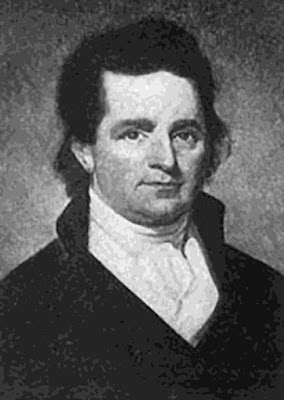


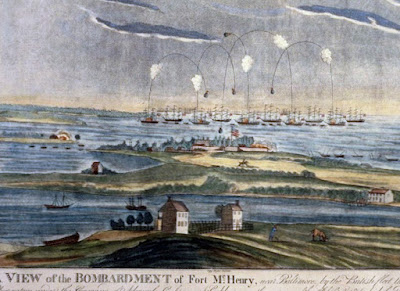





















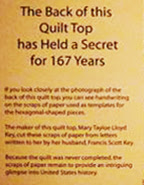
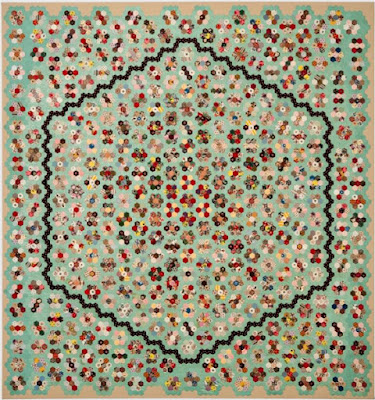
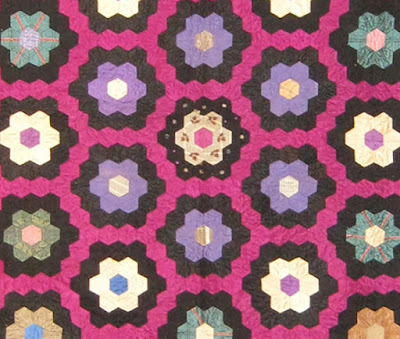




No comments:
Post a Comment